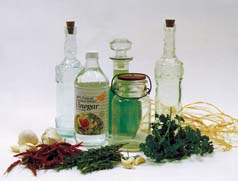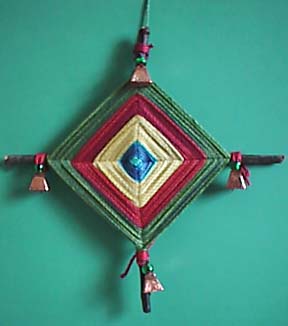 |
How to make Herb Vinegar 
Making herb vinegars is easy and rewarding. The colors are lovely, the taste is delicious and the process is satisfying.
Some general guidelines:
Cut herbs in the morning, if possible, after the dew has dried but before it gets hot. The essential oils will release from the herbs at about 85 degrees F.
Never put your vinegar in a container whose previous contents are unknown to you. It is not a good idea to buy bottles for vinegar at flea markets or yard sales.
Check the vinegar you are going to use for acidity. Any vinegar with 5% acidity can be used to make herb vinegar.
Basic directions:
Sterilize pint or quart jars.
Gather fresh herbs. Wash and pat dry herbs.
Put herbs in sterilized jar. Remember, you can always dilute the vinegar if the herb flavor is too strong; you cannot easily strengthen the herb flavor if it is too weak.
Add vinegar to cover the herbs. Do not heat the vinegar; use it at room temperature.
Put a non-metallic lid on jar and store in cool, dark place for 2-4 weeks. Check it after 2 weeks for flavor and aroma.
When the vinegar has reached the desired flavor, strain it to remove the old herbs.
Place one or two fresh herb stems in a sterile bottle. Pour in strained herb vinegar and seal. The new herbs are primarily for decoration.
Label vinegar. Enjoy.
Use herb vinegar in salad dressings, marinades, or to deglaze pans.
Selecting a vinegar:
The most commonly used vinegars are red or white wine vinegars and cidar vinegars. Rice wine vinegar, sherry vinegar and other specialty vinegars may also be used. Distilled white vinegar is easy to obtain and will make a nice herb vinegar, but it will have a sharper flavor than the wine vinegars.
Select a white vinegar if the herb will color the vinegar.
Use a red vinegar if the herb has a strong flavor.
Some favorite combinations:
Chive blossoms and white wine vinegar.
The chive blossoms give the vinegar a lovely pink color and light onion taste.
Lavendar blossoms and cidar vinegar.
This is truly special. It is almost effervescent.
Basil, oregano and thyme in a red wine vinegar.
A rich, full flavor that is excellent in salad dressings and marinades.
Rosemary in a white vinegar.
This makes a nice hair rinse after a permanent. It removes the "skunky" scent of the perm. It can also substitute for a mouth rinse in an emergency.
-----------------------------------------------------------
Experiment. Use the herbs you enjoy. Be generous in the amout of herbs you use to make the vinegar. It is hard to have anything but success in making herb vinegars.
|
 |
 | |
|  |
 |
God's Eyes
A God's Eye is a great craft to make at probably any of the Sabbats. I've seen them made at Imbolc, and then they're usually renamed as "Goddess Eyes." Works for me.
To make a God/dess Eye, you'll need:
1. 2 sticks; I've found that bamboo skewers work really well
2. yarn of different colors; save left overs from knitting / crochet projects
3. scissors to cut the yarn
As with any craft found here, you are encouraged to charge your materials in your normal way.
Make a slip knot on the end of the yarn you'll use for the middle of the cross, and slide the loop over the two sticks. Once you've centered the yarn, pull the knot, and spread the stick arms out into the form of a cross. Wrap the yarn diagonally over the center twice for each side (NW-SE, and then NE-SW).
Begin wrapping the yarn around the sticks, always remembering to move deosil around the eye. Start at one point, move the yarn over the stick, come around the back crossing over the front and moving on to the next arm. Remember - always go over the stick and then go around it. And keep the yarn tight.
When you need to add another color, figure out where you need to place the knot of the two strands so that it's hidden behind a stick arm. As you wrap the stick, wrap the loose strands to hide them. When you're done, doubly loop the yarn over the final arm.
To hang, cut 12" of yarn. From the front of the eye, push an end on either side of an arm about 2/3rds the way up the arm. Knot the ends in the back. Bring the strands together, determine the length for dangling, and tie a knot. Hang your eye, and enjoy.
P.S.
I've seen God's Eyes made using embroidery thread and jewelers wire. These were then were attached to earring hooks and worn. They looked cool, especially when metallic thread was used.
© 2001 Mother

|
 |
 | |
|